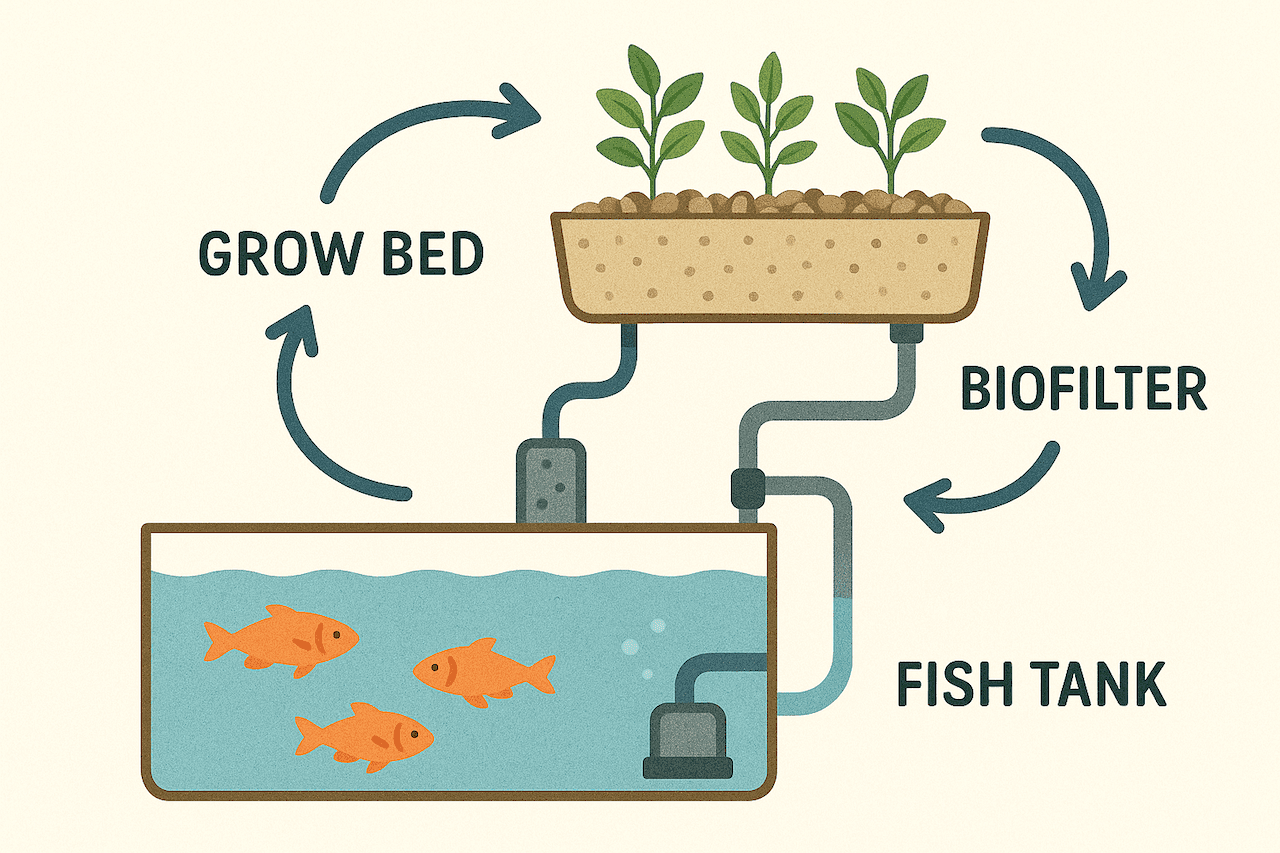Aquaponics: A Practical Guide to a Closed-Loop Growing System
hydroponic alternatives combines aquaculture and hydroponics into one circular, water-efficient food system. This guide explains how an aquaponics system works, what you need to set it up, and when it outperforms traditional methods.
 Closed-loop aquaponics: fish tank → biofilter → grow bed → return.
Closed-loop aquaponics: fish tank → biofilter → grow bed → return.Why it Works
Sustainable fish and plant system links fish and plants into a single ecology. Fish produce ammonia; beneficial bacteria in a biofilter convert it first to nitrites and then to plant-available nitrates; plants absorb those nutrients and clean the water for the fish. The result is a low-waste, high-efficiency loop that uses around 80–90% less water than soil gardening while producing herbs, leafy greens, and even fruiting crops in compact spaces.
Because the system is recirculating, you control inputs precisely: temperature, pH, dissolved oxygen, water flow, and light. That control makes an water-saving farming techniques system ideal for urban balconies, greenhouses, restaurants, and educational labs—and a powerful complement to sustainable food production.
Aquaponics System: How It Works
- Fish tank: The source of ammonia. Choose hardy species (tilapia, catfish, carp, or goldfish for small builds).
- Biofilter: Media (expanded clay, lava rock, or moving-bed K1) hosts nitrifying bacteria that convert ammonia → nitrite → nitrate.
- Grow bed: Plants take up nitrates and micronutrients; roots also trap solids for later mineralisation.
- Return line: Cleaned water flows back to the fish tank; aeration keeps dissolved oxygen high.
Keep pH between 6.6–7.0 (a compromise for fish, bacteria, and plants), maintain good aeration (>6 mg/L O₂), and size filtration to bioload. A reliable pump and an uninterrupted power supply are non-negotiable.
Three Common Set up
- Media bed (ebb-and-flow): Most forgiving; ideal for beginners. Media hosts the biofilter and supports roots.
- DWC (deep water culture): Plants float on rafts over nutrient-rich water; great for uniform salad greens and basil.
- NFT (nutrient film technique): Thin water film through channels; efficient for fast greens, less forgiving with solids.
Many growers hybridise—media for fruiting crops and solids handling, DWC/NFT for leafy greens. That mix balances productivity and maintenance.
Starter Checklist for Your this System
- Match tank size to plant area (rule of thumb: ~25–40 L of fish tank per 0.1 m² of dense greens in media beds).
- Cycle the system fish-less using pure ammonia or humic sources; test for the classic ammonia ↓ nitrite ↓ nitrate ↑ curve.
- Add fish slowly after nitrite is near zero; monitor feeding and remove uneaten food.
- Plant heavy feeders (lettuce, chard, basil, tomatoes, peppers); interplant herbs for pest balance.
- Maintain redundancy: spare pump, airstone, and battery backup for aeration.
History and Future of this urban farming innovation
While modern aquaponics draws on hydroponic science and controlled-environment agriculture, the core insight—linking water, fish, and crops—echoes older traditions. The chinampas of Mesoamerica and Asian rice–fish systems both paired aquatic life with plants to recycle nutrients. What’s new today is precision control: sensors for pH and conductivity, automated dosing, and lighting schedules tuned to cultivar and season.
Expect growth in three areas: micro-farms that supply restaurants with just-in-time herbs; education, where students learn ecology, chemistry, and engineering hands-on; and resilience, where compact systems buffer supply chains during heat waves or water restrictions. As renewable energy gets cheaper, off-grid aquaponics and rooftop farms will become practical for cities.
Aquaponics vs. Hydroponics (and Soil)
Hydroponics delivers rapid growth with exact nutrient recipes but requires regular mixing and disposal of solutions. Soil excels at buffering mistakes and supporting complex microbiology but uses more space and water. An aquaponics system sits between: you feed fish, not bottles; bacteria craft balanced nutrients; water is reused; and plant quality is consistently high. If you want low-waste greens plus edible fish—and you enjoy system tinkering—this approach is hard to beat.
Further reading
FAQ — Aquaponics
- What’s the ideal pH?
- Keep 6.6–7.0. Below 6.4 slows nitrification; above 7.2 reduces micronutrient availability.
- Which plants thrive first?
- Lettuce, basil, mint, chard, pak choi, and tomatoes. Start with fast greens while the biofilter matures.
- How many fish per litre?
- For beginners, plan low density: roughly 15–20 kg of fish per 1,000 L of water once mature, with robust aeration.
